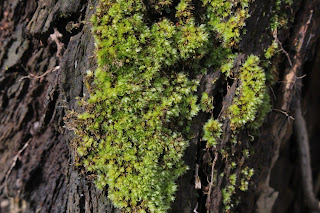Many early spring wildflowers still have yet to emerge, but I found a few things of interest.
My main reason for going out was to check out a population of False Rue Anemone (Enemion biternatum). This species is ranked S2, with between 5 and 20 occurrences in the province. I visited this population last spring and was pleased to find many individuals. This time around, the plants were yet to flower, but I found hundreds of plants, way more than last year, and I turned up plants in places I didn't note them previously. Should be nice when they flower!
Here is is in flower, from last year.
Another species of interest was Cut-leaved Toothwort (Cardamine concatenata). This is a common spring wildflower. While I didn't see any in flower, by the looks of it, that should be happening soon!
Canadian Wild Ginger (Asarum canadense) is just starting to peek up from beneath the leaf litter.
Wild Leek (Allium trichoccum), also known as "Ramps", was fairly prevalent in this natural area. The variety I saw was Wide Leek (A. t. var. trichoccum). It can be told from the much rarer Narrow-leaved Leek (A. t. var. burdickii) based on its reddish basal sheaths, leaf width (>2cm), and petiole length.
There is an uncommon "albino" form of Wide Leek, with uncoloured basal sheaths (which is like Narrow-leaved Leek), so identification of this variety must be made with the combination of the other characteristics. This "albino" form is seen below.
Another nice early season plant is Early Blue Cohosh (Caulophyllum giganteum). Like the name suggests, it emerges in the early part of the growing season. It can be differentiated from Blue Cohosh (C. thalictroides) by its purple flower (the latter has a yellow-green flower). Additionally, Early Blue Cohosh flowers before its leaves open, whereas Blue Cohosh flowers after its leaves open. Early Blue Cohosh typically flowers a couple weeks in advance of Blue Cohosh.
A favourite of many naturalists is Bloodroot (Sanguinaria canadensis), named for the reddish sap that can be seen when the root (rhizome) is broken.
Northern Spicebush (Lindera benzoin) is somewhat locally abundant in the area. It's just the buds now, but soon they will brighten up the forest with their brilliant yellow flowers.
I would be remiss if I didn't throw in a couple mosses.
 |
| Rosulabryum capillare |
 |
| Schistidium apocarpum |
 |
| Yellow Yarn Moss (Anomodon rostratus) |
 |
| Delicate Fern Moss (Thuidium delicatulum) |
 |
| Silvery Bryum (Bryum argenteum) |
 |
| Dwarf Anomodon Moss (Anomodon minor) |
Bird-wise, I saw my first of year Yellow-rumped Warblers and Hermit Thrush. Lots of Golden-crowned Kinglets today.
It is a very strange world we live in currently. Hopefully you can get out safely and still enjoy some of what has to be offered around home!













No comments:
Post a Comment